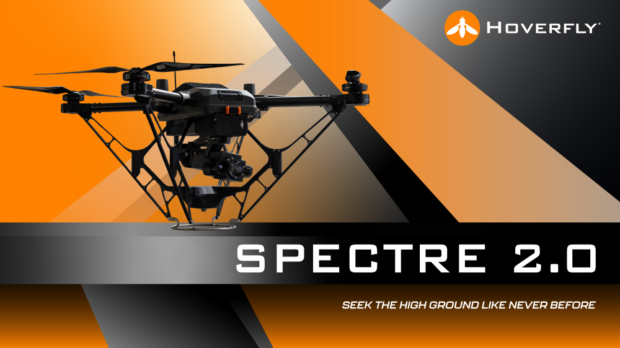., a worldwide supplier of tethered drone technology, has released Spectre 2.0, the newest tethered system for mission critical situations. The new platform offers various performance improvements to its predecessor and has expanded carrying capacity with open architecture to accommodate many different payloads.
Early adopters of Hoverfly technology will quickly understand the advancements and efficiencies of the new system.
Standard Platform, Multi-Mission Capable
Spectre 2.0 is no different from other robust, rapidly deployable tethered UAS provided by Hoverfly. Either vehicle mounted or stationary deployment, the system is soldier ready and field proved for on demand, persistent surveillance and communication network extension (designed in accordance to MIL-STD 810). With only minimal changes to the overall form factor of the system the carrying capacity has progressed to 5+ lbs. The elevated payload capacity allows not only more advanced payloads, but also multiple payloads. The open architecture has dual ethernet and power connections on the aircraft to eliminate any batteries for long endurance missions.
Advanced EMI Resilient Design
Designed in accordance to MIL-STD 461, the Spectre 2.0 is purpose built to radio payloads for communication network range extension. Often referred to as the Variable Height Antenna (VHA), Hoverfly systems have been the backbone of soldier networks for years. The enhanced aircraft design, along with the increased payload capacity, allows for additional radio integration for maximum distance connection.
Software Upgrades, GPS Denied Operation
Spectre 2.0 comes ready with advanced self protection logic, allowing the system to monitor itself and land should it find the environment is no longer suitable for flight operations. Further, the ability to operate in a GPS contested environment will be available for the Spectre 2.0. This new capability has proven its effectiveness in combating pervasive GPS jamming devices. This marks a historical achievement for tethered aircraft and was part of the operational requirements for several Department of Defense stakeholders.
“We’re thrilled to bring this new platform to market with many new advanced capabilities” said Steve Walters, President and COO of Hoverfly. “Our engineering team has done a tremendous job working diligently on designing a comprehensive tethered platform that offers both surveillance and communication network extension capabilities. I’m excited to get these systems in the hands of the end users to see their reactions to the dramatic improvements we’ve implemented for these new platforms.”
Source: Press Release

